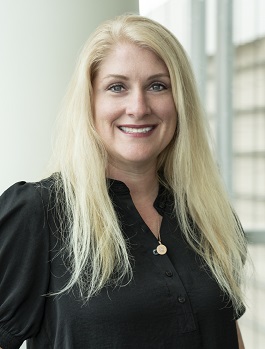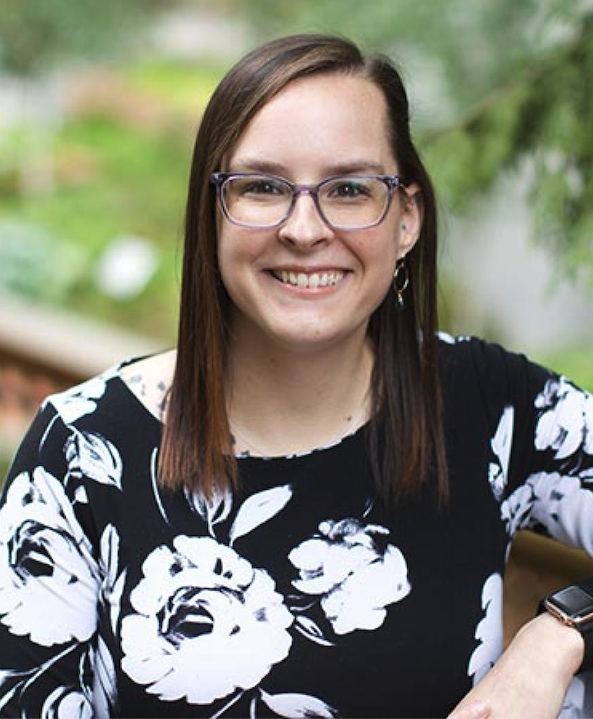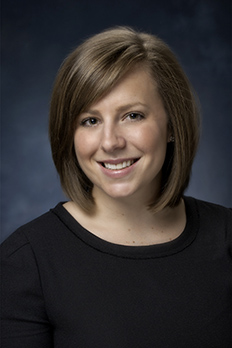Updates in the Management of Chronic GVHD: An Advanced Practice Perspective
Module 3: Beyond Second-Line Therapy
Erin Kopp, DNP, ACNP-BC, BMTCN, Adrianne Maurer, MSN, RN, AG-ACNP, BMTCN, and Katie Sellers MPAS, PA-C, talk about new agents on the market, the role of clinical trials in a patient’s care, and what tertiary centers offer. The faculty reviews the use of axatilimab in the third-line setting and important data that came out of the AGAVE-201 and REACH3 studies.
Chair

Erin Kopp, DNP, ACNP-BC, BMTCN
City of Hope
Faculty

Adrianne Maurer, MSN, RN, AG-ACNP, BMTCN
Fred Hutchinson Cancer Center

Katie Sellers, MPAS, PA-C
Texas Oncology Blood and Marrow Transplant
Transcript
Erin Kopp:
Welcome to part three of our roundtable discussion about chronic graft-vs.-host disease. My name is Erin Kopp and I'm back with my colleagues, Adrianne Maurer and Katie Sellers. So today we're going to talk about what is beyond second-line therapy? What new agents are on the market? What role do clinical trials have in our patient's care? What can a tertiary center offer that maybe you can't find in the community? And most important to us is what's the role of the APP? So, to give you some background, I have been practicing as a nurse practitioner for 16 years, and 10 of those years have been in this space. And I was lucky enough to be in a chronic GVHD clinic where we saw the worst of the worst. And it was wonderful in the sense that it gave us an opportunity to try a lot of things and see what worked.
But I will say that 10 years ago, it was trying. It was just what are we going to try? What are we going to do? And there was some understanding of the chronic GVHD initiation process and what perpetuated the cycle. And so, we attempted to align our agents we would treat with with our understanding of the underlying process.
However, it was very much a hodgepodge of whatever the clinician's experience was, or what they had read about happening in other spaces. So, when we saw a patient that was resistant to the one mainstay, which was corticosteroids, we just tried everything else. So, we have discussed a little bit about what's beyond second-line therapy. So, we know that we have our corticosteroid as our main first-line therapy. And in a previous discussion, there was a review of ECP and MMF and sirolimus and tacrolimus. We could probably write a book with all of the agents we could have chosen from. And there wasn't a real focus on what would make the most sense. So, I want to ask you two ladies before I go on, go back five years ago, how did you choose an agent that was second- or third-line for your patients that presented with chronic GVHD?
Adrianne Maurer:
It really felt like picking something out of a hat, to be honest. And five years ago, I was still a baby APP, still learning and using the NCCN Guidelines for everything and anything. But I want to out that those guidelines haven't changed all that much in the last five years. They still recommend steroids as your frontline therapy, but second line, it's kind of a physician's choice for the most part.
Katie Sellers:
I would just grab for what my physician recommended, "Hey, we had a patient with sclerotic features. I found X, Y, and Z helped." And so, we would kind of use patients that had responded to certain things or we had seen ample response in a certain system, we would reach for that drug. And then if we had another example, we would reach for that drug. So, it was almost using our day-to-day experience in the management of other patients to manage our current patients.
Erin Kopp:
Katie, I love that you brought up the point that you just did kind of what your physician said. Adrianne, I think you had that same experience. And so, this is where the APPs can really step in and have a role as collaborators. Because as professionals, the more understanding we have, the more we can advocate for our patients. And so, I have a process that I like to look at now when I'm thinking about what second-line therapy or third-line therapy or beyond. So how do I choose? How do you choose? How do we choose? It's really thinking about what the presentation of the patient is. Where is the GVHD? What system is it in? So, I start there and then I look at the science that's available to us. What do we understand about chronic GVHD and what do we have in our arsenal that may or may not be a particular agent that works great in that system?
And what's the availability to the patient and the accessibility? Because if the medication doesn't get in your vein or in your mouth, it's not effective at all. Couple of other things. What is my goal? Time to result? Do I have a month because sometimes that’s how long these agents take to really see the true effect? Do I have a week because it's more of an acute progression? And finally, what adverse events am I anticipating? That's a big thing that I look at every single time I review a study or review even anecdotally what we've seen with our patients.
So that is the guidelines that I use for what's beyond second-line therapy and looking at what new agents are on the market because it's new and it's sparkly and it's shiny, it doesn't mean that it's the best maybe for that individual patient. But I would ask all of you, the APPs on this, reviewing this discussion, to step back and think about what do you know about chronic GVHD? So, the very basics is there are a lot of variables that cause and perpetuate GVHD in the chronic setting. And our first focus was definitely in the T cell, whether it be T effectors, the imbalance between T regulating cells and effector cells.
And then there was the thought of, well, there's B cells as well when we're talking about the immune system. And then without getting complete response in lots of these studies, whether it's best available therapy or newer agents, then it was do we look in other spaces, in other mediators of inflammation, other mediators of the fibrosis that can happen secondary to inflammation and study those? So that's the landscape of what's happening now. Adrianne, in your space, are you seeing a lot of introduction of these newer agents? Where are you at in your practice?
Adrianne Maurer:
Absolutely. Yes. I think from a practice standpoint, Jakafi, or ruxolitinib, is the second-line for everyone, almost bar none. The one thing that really ends up being a large limiting factor is financial toxicity for especially patients who are in that Medicare donut hole, the copay can be really expensive and sometimes the same for belumosudil. So that's one of the other things that I add into my checklist as we're making decisions about what the next line therapy is. Is this something that is feasible for the patient too?
Erin Kopp:
Katie, I see you shaking your head, so I imagine we're talking about cancer, so financial toxicity is something we can't ignore. And I think as APPs, we think about that far more often than maybe our colleagues do. And so clinical trials have kind of a benefit in that sometimes. If there's a clinical trial, many of these agents in the testing are covered, and then when they transition. So, I want to talk a little bit about mentioned belumosudil and ruxolitinib and ibrutinib. These are FDA-approved agents. Do you have two other specific therapies or three other specific therapies that you've already gone through and have an idea of how we progress through therapies? Now we can talk about that, but then we're combining therapies in different ways and seeing how they work. But all of those agents have followed along this very traditional trajectory of: we identify BRT issues, they address those issues, and they've been relatively effective.
When we had the ruxolitinib REACH3 study, it was comparison head-to-head, which is very unusual of an agent versus best available therapy, and you're getting an overall response rate of about 50%. Overall response rate is a critical piece here because it does not necessarily mean complete response. So that's where the gap is, right? Why do we keep trying for something better? And so, we have these other agents and ibrutinib is effective we see in maybe specifically oral chronic GVHD. I know in the trial we had worked in that and we saw a lot of efficacy in oral, but that was about it.
So now we're looking at, in the third-line setting, I want to introduce axatilimab as something totally different that focuses specifically on the CSF receptor as a novel target for therapy for chronic GVHD. And so, this is a different mechanism of action. Instead of going directly to B cell or T cell and modulating the immune system, this is actually trying to do a different pathway later on for that inflammation that happens that is preceding the fibrosis that we see.
We talk a lot about early diagnosis, so I cannot stress that enough. But when we get to a point where there's ocular damage, there's fibrotic changes or sclerotic changes, the same thing that we see in the joints, fascia changes, many of those are almost impossible to reverse. So, the concept of adding another agent that attacks this disease in a different way that looks at that in particular is very intriguing. So, the AGAVE-201 trial was the randomized multi-center trial investigating three different doses of axatilimab. And then as of August 2024, the FDA approved this agent to be utilized after two prior lines of systemic therapy in both adult and pediatric patients that weighed at least 40 kilograms. So, before I go on with that, Katie, Adrianne, any experience with axatilimab in the clinical trial setting or reading about it?
Katie Sellers:
So, unfortunately, we were not able to have it in clinical trial at our center. We did refer a few patients out to centers that were able to offer it, for patients who did need kind of that rapid durable response that axatilimab offers. So, I am eager to get my hands on it once manufacturing is up and running. So, I am obviously very excited to now have another option to offer our patients. I think it's just incredible that since 2017, we've now had four FDA approvals for GVHD, which is just for a landscape that we didn't know that we were... Again, we were kitchen sink or grasping for straws, to have four approvals as exciting. So, I think I'm really excited. It's a unique mechanism of action. The efficacy just looks incredible, so I think I'm excited to be able to use it to be able to speak to experience more. And so, I am envious that you had that.
Erin Kopp:
Adrianne, what about you? Did you have experience, get your hands on it?
Adrianne Maurer:
I had a few clinical trial patients on it towards their tail end of the accrual process, so I didn't get to see a ton of results, but I have read through the AGAVE-201 data, which is really, really promising.
Erin Kopp:
And that's really going to be the experience of most people. Just there are clinical trials and so that's one space I did want to just touch on is that the benefit of a tertiary center is that we have access to clinical trials. So, if you review NCCN guidelines, that's one key thing. If you're not getting a response, these are the patients that we need to refer out to tertiary centers so they can have access. And it's definitely the APP who often has to think of that and then coordinate all of that care.
But when we're talking about this medication in particular, axatilimab, the other thing we're going to be thinking about when you're reading all of this data, and please do go read the AGAVE-201 results, what are we thinking about in terms of AEs, right? It targets monocytes and macrophages. So it, great, impacts inflammation and fibrosis, but what are the side effects that we're going to anticipate in this population?
So, some of the things that you're going to see, as you might imagine, infection, some of the other issues that we have to look for is what are their LFTs look like? What are their labs in general look like? Are we seeing pain? Are we seeing fatigue? And it takes a lot of discernment from the APP, knowing when I start this new agent, I'm going to then connect and have that education, which I think you both have so beautifully articulated in some of our other discussions that it's that connection with the patient, so they know what to expect. Because I like to tell people, nothing's normal in this patient population, right? It is, what can we prophylax and what can we manage? The data was very promising from the AGAVE-201 trial with an overall response rate of 75% in the 79 patients that were treated with the recommended dosage. The median time to first response was 1.5 months.
So, keep that in mind. Chronic illness takes a little bit of time. Prepare your patients and prepare yourself for that, because we don't want to prematurely remove a therapy that has a potential for working. So overall, I think the goal of this summation of talking about chronic GVHD with these amazing experts was to really highlight the role of the APP, identify where we're going in terms of the future, and it's incredibly promising. And from either one of you, do you have any closing remarks about what you're looking forward to in the future and how you're treating your patients today and tomorrow? Katie, do you want to take that?
Katie Sellers:
I'm just excited that, number one, I get to offer more to our patients, and we give them a glimpse of hope. We've cured their underlying diseases. They have potentially life-altering chronic graft-vs.-host disease, and we're now at a time where we get to look at mechanism of action and we get to look at the targets specifically, and we have options available to specifically treat those targets. And I think that it's nice to have more in our armory. And so, while it's still incredibly challenging to identify and treat chronic graft-vs.-host disease, this is the best time. We've had the most options and research going into this area, and it helps the APP as well as our colleagues be able to care for our patients better. So, I think it's an exciting time to be in this field of practice.
Erin Kopp:
And Adrianne, any last remarks for you?
Adrianne Maurer:
I will just echo everything that Katie said, but also one of my favorite things to tell patients is that historically we've only been able to offer therapies that will help the progression of their GVHD, and now we're in a space where we can actually potentially reverse some of that. So that's really exciting and not something we've ever been able to tell patients in the past. So, Erin, you said there's no such thing as normal in chronic GVHD. What we're trying to achieve here is some sense of a normal life for these patients, and these new therapies are a nice bridge to get there.
Erin Kopp:
Yes. So, thank you, ladies so much. This brings us to the end of our chronic GVHD roundtable series. Adrian and Katie, thank you for sharing your expertise with me and with the viewers. For more information and to view other discussions on chronic GVHD, please visit JADPRO online at JADPRO.com.

